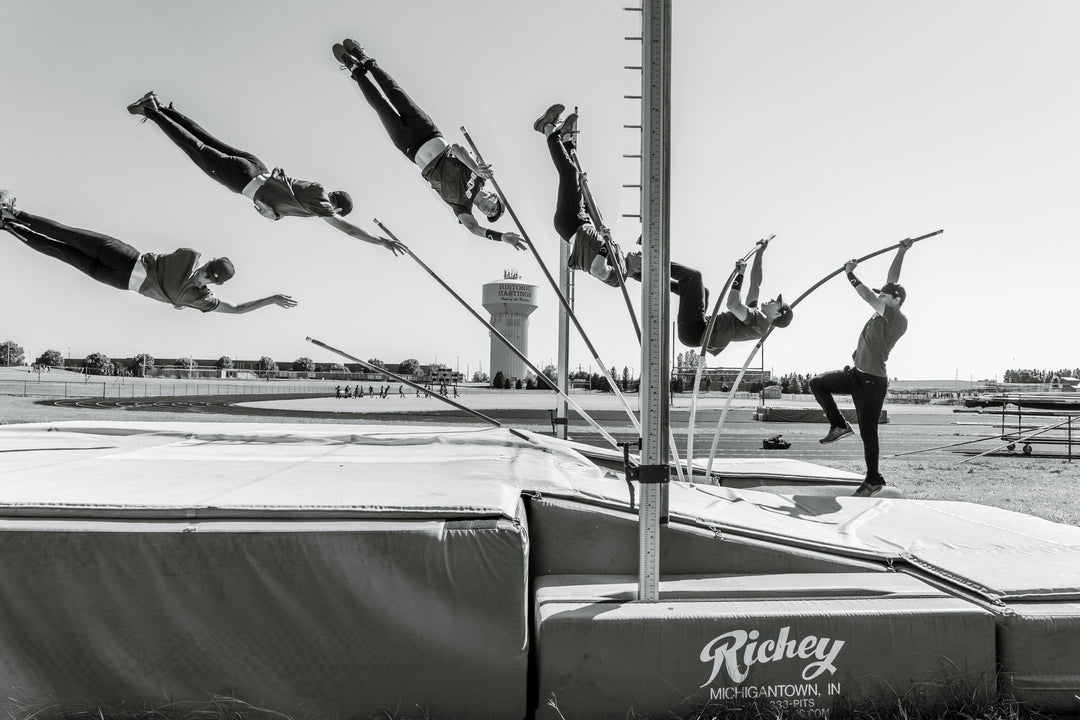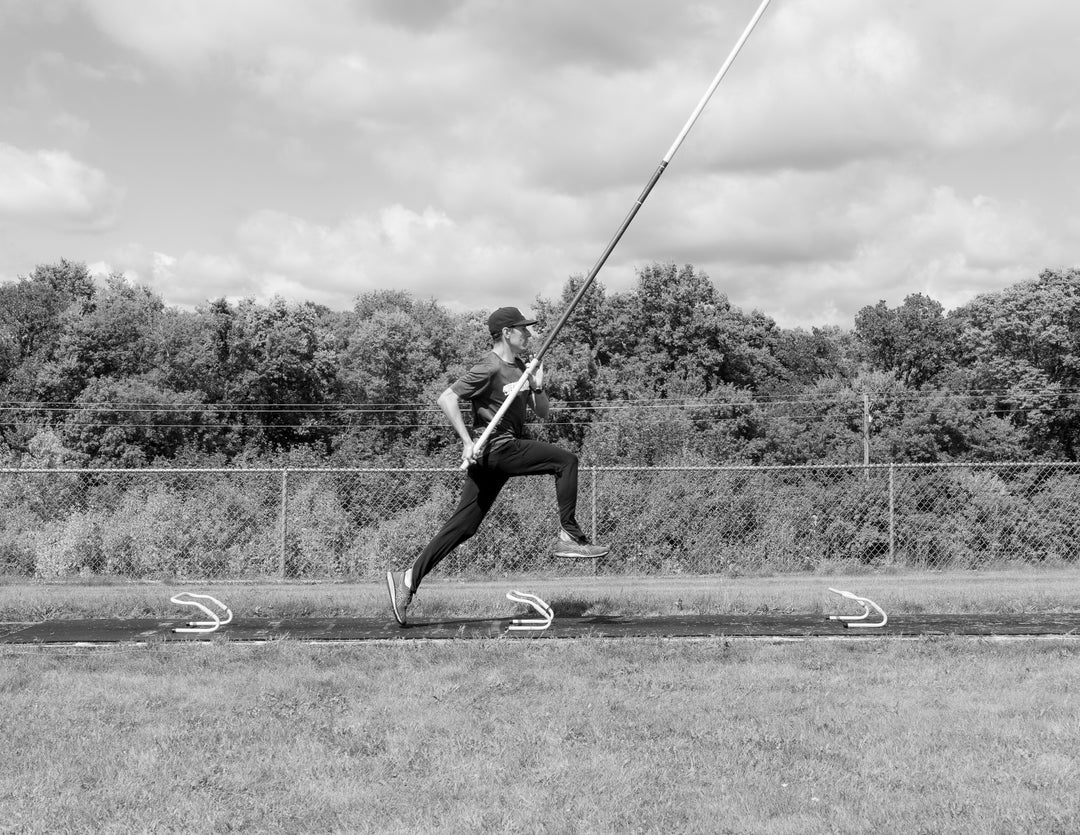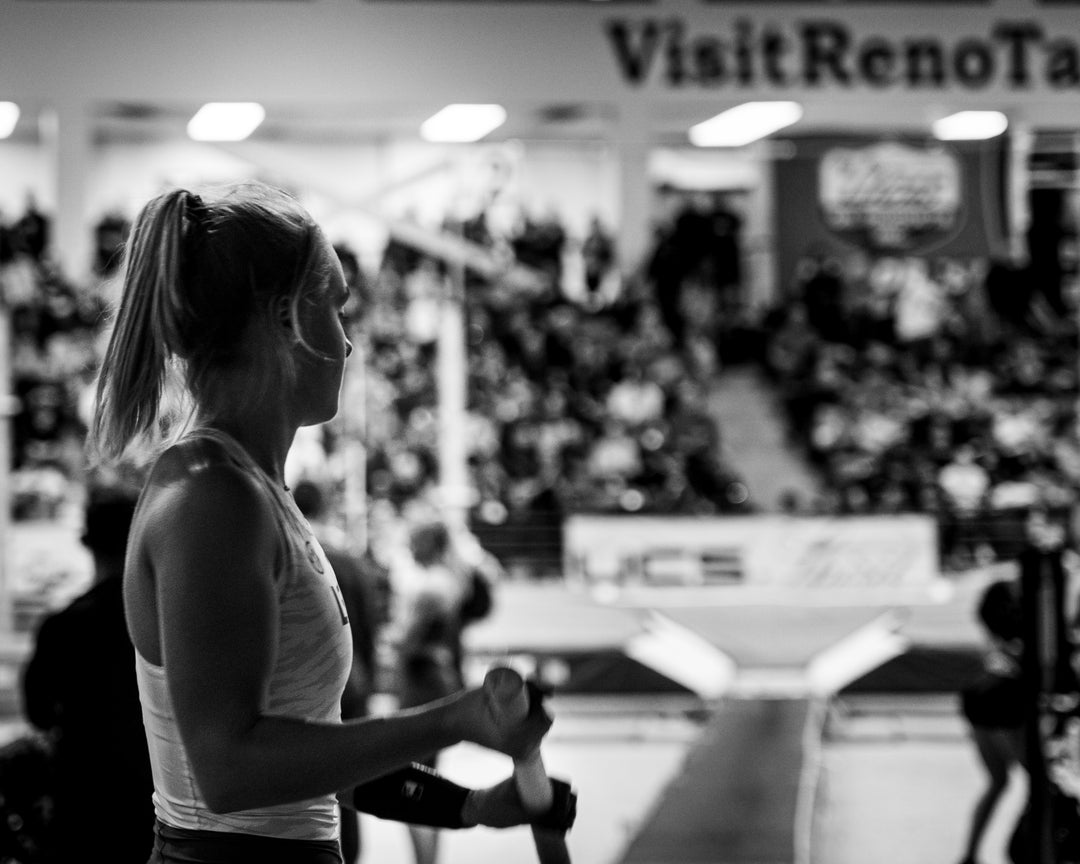Kris Allison Teaches us about Pole Vault Flex Numbers and some big problems...

I put this post out on facebook where there was a bit of a debate on the topic.
I'm like you where i'm still learning things about the sport from pole vault wizards.
Kris Allison threw some magic in the comments to help us understand how poles work.
Wilson Soohoo suggested I add this to my site. So here ya go!
Hope you learn something too
Kris Allison
I’ve been flexing poles for over 20 years. I’ve built 4 different flex testing devices. My last one was a collaboration with 2 engineers whose daughters I coached. I once measured 2 different brand 11’ poles on the same scale/span. They came in identical in flex. One was rated a 130 by its manufacturer. The other pole was rated an 80. When there is a 50lb discrepancy in weight rating at the same flex number, there needs to be a standard set in the industry. Until that happens, flexing your own poles is the only failsafe to know your true transitions in stiffness across brands and lengths.
David
how are you flexing these? Different pole lengths will have different results, and choosing where to hold the ends and where the sail piece ends makes a big difference in final flex. That is why it is nearly pointless to try and flex poles on your own as a comparison between brands - they are made differently, flexed differently, and have sail pieces in different locations. There is a reason there is not a universal system between brands.
Shawn Francis
Earl Bells system is super solid. I don't find it pointless at all.
David
my point is not all poles are built the same - different percentages of carbon fiber, g-glass, s-glass, mantel size, location of sail piece, etc makes a universal flex measurement difficult to standardized for comparisons between brands. The comment that "130 lb pole rated as an 80 pound pole on my system" is case in point.
I appreciate your response and you raise good questions and make good points. Lengthy answer so I apologize in advance but lots of info to disseminate…
I began flexing poles in my garage in the Fall of 2002 after learning how from my dear friend and mentor Earl Bell. My device mirrored his and Shawn’s but my quest for knowledge took on a different path, to dial my device in so accurately that I could pull any brand new pole out of a tube and measure it on my machine and match the factory flex. I am or have been a dealer for every US pole manufacturer and I wanted to be able to order poles perfectly by flex that would fill gaps in series and eliminate guessing and hoping.
One thing I learned was that the manufacturers did not openly share their “spans” or other technical parameters with many people. I had to “reverse engineer” those parameters by trial and error, varying span and weight and support points until I could hit factory engraved numbers perfectly about 85% of the time. I couldn’t hit them 100% though, so I contacted an expert, one of the major manufacturers’ engineer. He told me that the results will skew with the overhead suspended straps due to sway inwards under load, moreso on softer poles. I decided to abandon that suspended device and built a solid support with frictionless rollers like the ones I’d seen in all the factories. I got my flex matching percentage up to 95%. Still not perfect but better. A few years later I discussed my device and results with 2 engineers whose daughters I coached, and they thought the could improve on my design. They made their modifications and my accuracy improved to 99%.
Background: Learned how and why to flex from Earl Bell. Became a dealer for all US manufacturers. Tested literally thousands of poles on my devices using multiple sets of parameters (span, position of supports relative to sailpiece and butt of pole, weight, method, etc..). Spent dozens of hours on email, phone, and in the factory discussing, conferring, and examining test results with pole company owners and their engineers. Was a driving force behind one company abandoning an entire line of poles and launching another in its place due to inaccuracies. Have been a consultant on flex conversions for 2 of these companies when they were attempting to move clients from another brand onto their own.
Your points:
1. Yes, different pole lengths will and do have different results, some more than others.
2. Yes, choosing the location on the supports relative to the sailpiece does make a difference in flex, some more than others.
3. Yes, different brands do make poles differently, flex them differently, and have different sail piece locations (and shapes, materials, and dimensions).
Now as to whether flexing them is pointless, you have to look at what information a flex test provides you. It does not tell you how the pole bends (low, high, symmetrical). It does not tell you how the pole recoils (slow or quick or medium). It does not tell you if it rolls over better into the pit or stands vaulters up at vertical.
A flex test tells you how much a pole deflects from its resting position with a 50lb weight suspended on it. It’s a testing method borrowed from “beam theory” that was applied to vaulting poles by composite engineers in the 1950’s and 60’s. A formulaic equation was developed to convert the flex number measured into load bearing capability in a way athletes and coaches would understand, test weight. People were familiar with test weight from fishing line. Early fiberglass poles like the Thermoflex and Browning Skypole even had charts on the labels that told the vaulter how high to grip for their body weight. How accurate was the flex-to-weight rating conversion? It’s a matter of opinion. By modern standards the old poles rate much stiffer. Weights were easy to comprehend though and probably made sales easier.
At least 2 pole companies attempted to adapt different methods to more accurately determine the test weight of a pole by buckling it in a machine with a load cell device attached that measure the force the pole resisted with. Once again as in the flex test, the load cell buckle test only measures resistance and not the other properties and considerations mentioned above.
What one engineer from one company did was extensively cross reference the load cell test results against flex measurements and adjust that company’s flex-to-weight rating chart to more accurately represent the pole’s resistance.
What I’ve discovered on this journey is this: if you have a consistent flex measuring device and system, you can flex poles of different brands and lengths and acquire a resistance number, which will at least let you know how hard one pole is to bend beside another at the same handhold. It won’t tell you how they’ll recoil, roll over, etc… but you can classify and order poles in terms of “relative stiffness” so that you don’t run the risk of grabbing what “should” be the next pole based on weight rating and getting spit back out onto the runway or over the back of the pit.
I actually flex all of my poles on 3 different spans… lower grip, medium grip, high grip, and classify my poles on my own system (1-infinity with each integer representing a flex range). For example, I have an Essx 12’7, Spirit 13’1 and Pacer 13’6 that all flex within .5 of each other on the same medium span. The Essx is stiffest on the lower grip span, the Spirit is stiffest on the higher grip span due to engineering differences.
Still, all these pole #33’s on my system can be picked up by the same athlete and planted knowing the relative stiffness is close enough for them to make the pit and make a safe attempt on any of them. Then the athlete can pick which one suits them the best based on the other factors (materials, sailpiece, response/recoil, rollover, carry weight, diameter, etc... Been doing that for 15 years.
So I wholeheartedly disagree that flexing your own poles is pointless because my practices with the thousands of athletes I’ve sent down my runways on just about every brand and length pole manufactured in the past 40 years has proven that it does work.
As for standardizing poles and my 80 versus 130 weight rating example… again, it comes down to relative stiffness. The 130 rating is from the company that did all the flex and load cell R&D. The 80 is from a company that doesn’t have an engineer on staff or a load cell. I put 3 athletes on both of those poles to gauge feedback. Each athlete weighed differently ranging from 120-140lbs. They all said the 2 poles felt the same in terms of stiffness, and neither pole broke after several jumps. I feel the 130 was properly rated and the 80 nowhere close.
I feel like load cell is a better test, but flex test works too. Come up with a better test, but I know if I buy a stick of schedule 40 pvc from 4 different manufacturers, schedule 40 is schedule 40 and every one can meet the pressure demands that they are rated for. The ASTM tried to get the manufacturers to sit down and agree on a standard many years ago. They bickered like children on a playground and refused to concede an inch. ASTM gave up. Uninformed coaches and athletes unintentionally buy duplicates, poles that are too stiff, and poles that are too soft all the time. I’ve measured at least 1 pole from every single company misflexed or mismarked at least once due to quality control issues. I sent those poles back at my own expense and asked that they re-test them and every company said my measurements were correct and that they made a mistake. So once again, no I don’t believe it is pointless.
Kris Allison
to clarify where you quoted me… one manufacturer rated their pole 130. The other manufacturer rated their pole 80. I didn’t rate the poles, I simply flexed them both on the same scale and they measured identical. I could care less what their weight ratings were as I organize my series by flex but Joe High School Coach doesn’t know any better when he opens the MF catalog and orders an 85 that is stiffer than his 130 from another company.
Shawn Francis
I'm saving this. Thanks for putting in the time to write and share, Kris!
Kris Allison
Shawn Francis, my pleasure! For the hundreds of hours I’ve spent lifting a 50lb weight on and off of poles I should have bigger biceps to show for it! 
For the original post Click here
For a video to see how poles are flexed click here
Hope this helps!
Happy Vaulting
- Shawn







Being a vaulter from the seventies and the ‘80s, the flex rate was a non-essential. It was entirely based on length and weight along with trial and error. Unless there’s a standardized way of checking flex rates with all brands, it makes it a great deal more complicated for vaulters and coaches. For instance, the more popular Pole right now for kids is Essx because they seem to be a great deal more forgiving and can grip down quite a bit giving you more range. At the same time it’s sail point is difficult to identify. I can take a UCS and know that the length/weight of the pole pretty much dictates the hold has to be within 6 in from the top. I understand how to flex poles myself and can make my own rating system in order to serve my athletes. But when it comes to purchasing equipment, it’s hit or miss especially when you’re getting into the elite vaulter. I coach at an NAIA School and we’re fortunate to be able to rent poles. Obviously that’s not the best financial stewardship position, but until the pole vault industry can unilaterally put together a consistent flex rating system, very difficult to invest properly into the right equipment.
At the NCAA level, because of the limitation in roster sizes to 35 pre gender, it’s going to become even more important to purchase the right equipment. There is no room for trial and error. As an NAIA coach that doesn’t have the budget to buy 60 poles to fit every need, I’m hoping manufacturers will begin to consider helping us out and put together something that helps coaches determine the correct equipment based on weight/length and flex numbers. Appreciated the article. But as a coach it didn’t help much when it comes to where the rubber meets the road in securing equipment. My rack looks like a smorgasbord of poles spanning 30 years. I’ve flex rated all of my equipment based on my system. It wouldn’t do anybody else any good, but it helps me determine where I can go with what I have. Still, very difficult when discerning how to purchase equipment a piece at a time when flex rates are so inconsistent and there’s nothing standardized. 😉
Being a vaulrer from the seventies and the ‘80s, the flex rate was a non-essential. It was entirely based on length and weight along with trial and error. Unless there’s a standardized way of checking flex rates with all brands, it makes it a great deal more complicated for vaulters and coaches. For instance, the more popular Pole right now for kids is Essx because they seem to be a great deal more forgiving and you can grip down quite a bit giving you more range. At the same time it’s sail point is difficult to identify. I can take a UCS and know that the length/weight of the pole pretty much dictates that the hold has to be within 6 in from the top. I understand how to flex pulls myself and can make my own rating system in order to serve my athletes. But when it comes to purchasing equipment, it’s hit or miss especially when you’re getting into the elite vaulter. My coach at an NAIA School and we’re fortunate to be able to rent poles. Obviously that’s not the best financial stewardship position, but until the pole vault industry can unilaterally put together a consistent flex rating system, very difficult to invest properly into the right equipment.
At the NCAA level, because of the limitation in roster sizes to 35 pre gender, it’s going to become even more important to purchase the right equipment. There is no room for trial and error. As an NAIA coach that doesn’t have the budget to buy 60 poles to fit every need, I’m hoping manufacturers will begin to consider helping us out and put together something that helps us coaches determine the correct equipment based on weight/length and flex numbers. Appreciated the article. But as a coach it didn’t help much when it comes to where the rubber meets the road in securing equipment.
Great information. Question, how do most accurately choose the “next pole” for a vaulter when we’re going up in length?
Thanks for sharing this insightful discussion! It’s fascinating to learn about the intricacies of pole flex testing and the importance of understanding relative stiffness in poles. Your dedication to refining your testing methods and sharing your expertise is truly commendable.
Leave a comment